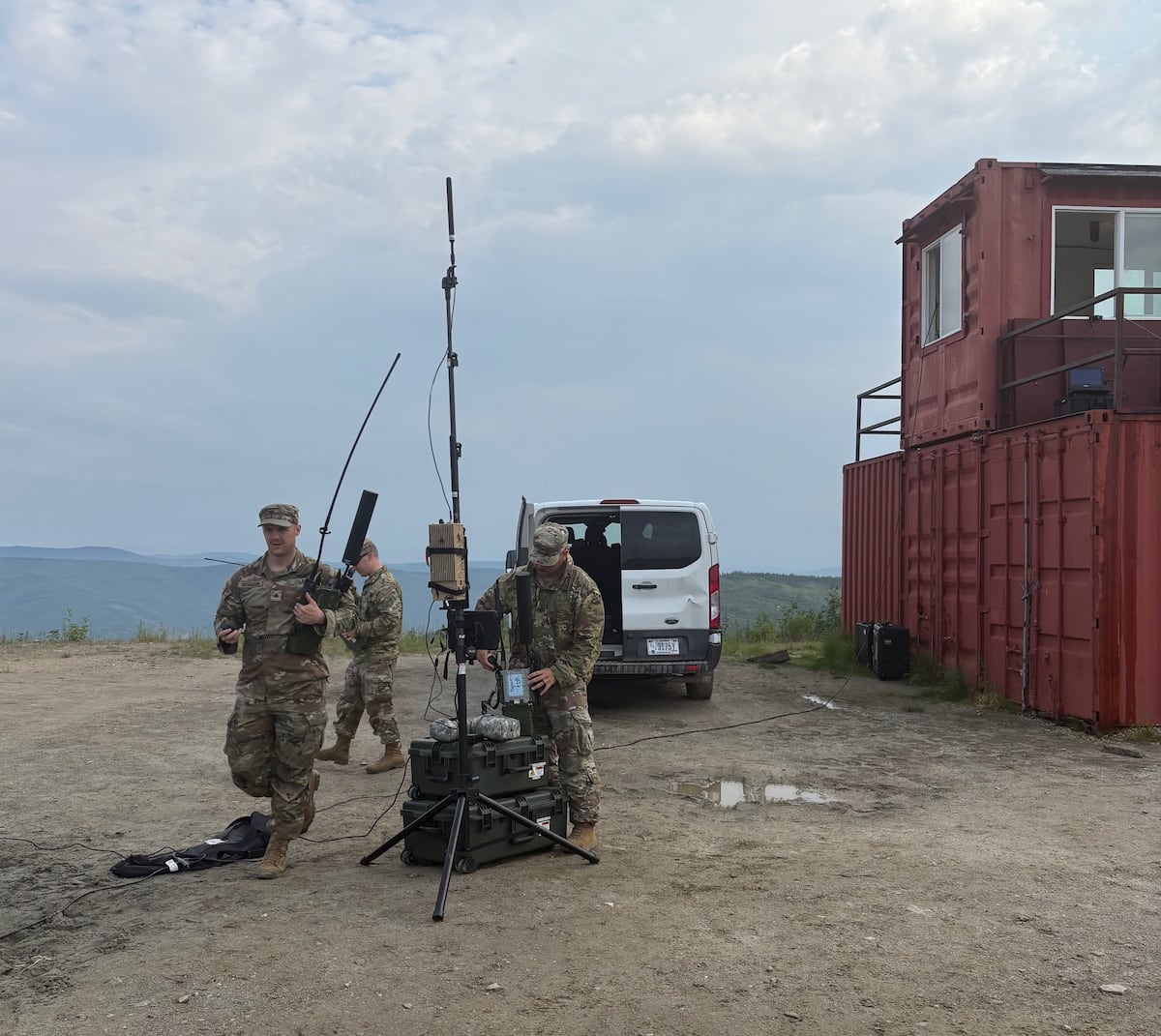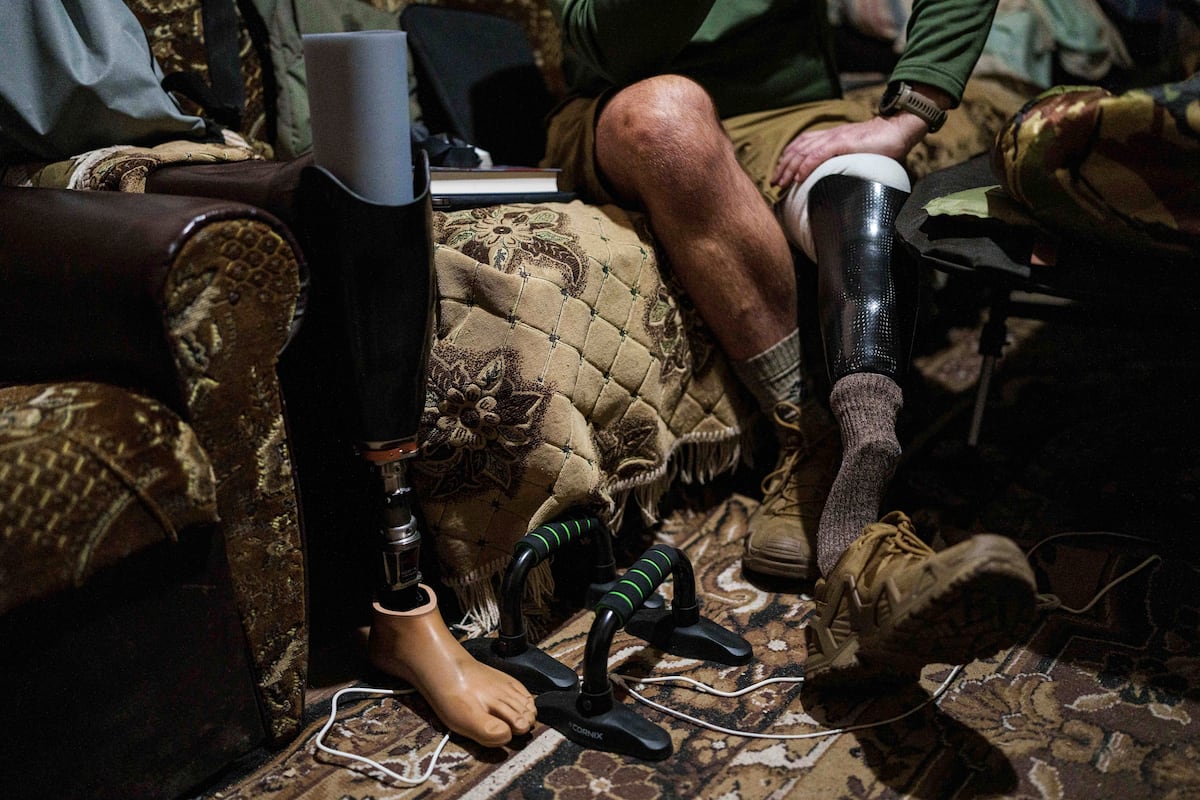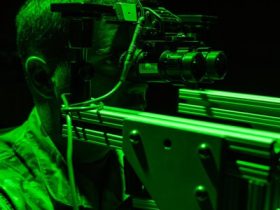For most of the firms that participated in a late June drone trial staged by the Defense Innovation Unit in remote Alaska, it was the first time their systems had flown outside of a lab setting.
The five companies brought drones and radio prototypes to a range near the U.S. Army’s Fort Wainright to see how they’d fare against simulated electronic warfare systems looking to jam their navigation and command-and-control capabilities. DIU was assessing whether any of them were ready to transition to the military services for further development or fielding.
With a few exceptions, the lack of field testing showed. While several companies made progress by the end of the four-day test event, they struggled initially to maintain targets and navigate flight routes. Some of that was due to jamming and some of it was because their technology wasn’t as mature as expected.
That outcome is not unusual for a prototype demonstration, DIU officials told Defense News during the event. In fact, the government team in Alaska wanted to see how the companies responded when the systems failed and whether they could iterate and come back the next day with a better solution.
That process is vital for both the DOD and the companies, but most small, commercial firms don’t have access to test space where they can learn and refine their products under the types of conditions they might face in the field. That’s a problem for the Defense Department, whose leaders want to field technology — and drones in particular — from a broader pool of companies and at faster rates.
DIU’s Trent Emeneker, who leads several autonomy projects for the organization and helped facilitate the Alaska testing, said in order to field systems that meet the needs of troops on the ground, DOD needs to change the way it tests in two key ways — by providing more opportunities for small tech companies to wring out their systems, and staging those tests in the field with military operators.
“If we want to succeed, we have to embed engineers with warfighters, and we have to be out in the field testing,” he said. “We have to do it all the time.”
Commercial access
Helping DOD get to that “all-the-time” testing cadence is a rising priority for DIU.
In June, it announced a prize challenge called Project G.I., which calls for “ready-now” uncrewed systems that can help increase the effectiveness of small military cells operating in low-bandwidth environments with disrupted communications. Companies selected will participate in a live demonstration with military operators and a subset of those will advance for a chance to either receive funding to mature their systems or contracts to deliver capabilities to military units for further testing or prototyping.
A second effort, DIU’s new Range Strike Group, was launched earlier this summer to take a wholistic look at the testing challenge. Will Ryan, DIU’s autonomy portfolio manager and one of the leaders of the task force, said the group is still in the early phases of defining the problem and formulating ideas for how to address it. From there, it will craft recommendations and identify offices within DOD that are best positioned to move them forward.
Ryan told Defense News that improving test access for a wider swath of companies benefits not only the firms themselves but the Defense Department — especially as it looks to field technology that both works and can be delivered on faster timelines.
“Providing an opportunity for these companies to assess their products in a contested environment against a notional threat is really valuable, one, for the DOD to assess their product in that way,” he said. “But it’s also important for the companies to see where they’re succeeding or where they’re falling short so they can make tweaks and have a better product.”
One of the group’s early tasks is to identify the policy hurdles that programs have to clear in order organize an EW test event. DOD has its own policies around spectrum management as do the Federal Aviation Administration and Federal Communications Commission, which require programs to go through an approval process to perform any testing that interferes with GPS or communications signals.
Programs that are testing outside of a military installation also need waivers from the FAA to fly aircraft at distances that extend further than what an operator can see, or beyond the visual line of sight. Some requirements are eased for testing on DOD bases because the airspace around the installations is restricted.
Another challenge: Many military ranges aren’t equipped with the infrastructure to support EW testing — and if they are, program managers looking to schedule a test have to navigate a slew of policy and safety restrictions to minimize the impact of GPS disruption on nearby cities or towns as well as commercial aircraft.
DOD’s most advanced ranges, like White Sands Missile Range in New Mexico, are in high demand by some of the military’s most complex systems, making it hard for smaller programs and companies to access them.
John Sawyer, a UAS analyst in the Pentagon’s acquisition and sustainment office who helped coordinate the Alaska testing, said all of these challenges add up for programs who don’t have access to significant resources and are running tight schedules.
“If you’re looking to do it on the cheap with a very minimal budget and you’re looking to do it on an accelerated timeline, it’s tough,” he told Defense News.
Ryan said the Range Strike Group may be able to help find new testing locations and explore ways to either streamline them or ease them under certain conditions to ease the burden on test organizers.
“It’s not throwing them away or ignoring them — it’s how can we streamline them or assume the right amount or risk whatever set of environmental conditions exist. Like here,” he said, referring to the remote Alaska test site, “Do those policies apply as much as they do somewhere that’s closer to New York City?”
Location, location
Knowing it would take time to find the right location for DIU’s recent EW tests, Emeneker started scouting locations for the electronic warfare last summer. He cast a wide net, putting Ukraine at the top of the list.
“There’s no better place in the world to test,” he said.
Drones have been a major feature of the war and Ukraine’s battle-tested approach to bottom-up development and rapid fielding and iteration is one the U.S. military and its allies want to replicate — or at least draw lessons from.
Since the early days of the war, well-connected and funded U.S. companies have traveled to the front lines to test their systems against live EW threats and get a better understanding of what capabilities Ukrainian drone operators most needed.
Chris Bonzagni is a former DIU program manager who now runs a defense consulting firm that helps U.S. drone firms test in Ukraine. Since leaving DIU in 2022, he’s traveled to the country many times and seen firsthand how the urgency of war has driven innovation and experience for the military and for the commercial firms that support it.
“In Ukraine, these guys are not afraid to fail and they’re doing it because they have to do it and there’s necessity there,” said Bonzagni, who was on the ground in Alaska supporting EW testing. “The difference between those guys and here is they have access to ranges and they just do reps and reps and reps and reps. Here, you see how much we have to do to get all the resources.”
However, without support, it’s not feasible for most small firms to navigate the process for in-country testing, Bonzagni told Defense News.
“The logistics are hard to get in,” he said. “The well-capitalized startups that can invest that time and invest that equipment are able to do so and the smaller startups are definitely prohibited.”
Bonzagni said this is an area where the Defense Department could help create a process to send firms to Ukraine, but the U.S. military has long been wary of formal involvement. Following President Donald Trump’s election to his second term last November, the growing political strain between the incoming administration and the Ukrainian government has made it harder.
For DIU, that meant the odds of getting the approvals to stage DOD-sponsored testing in Ukraine grew slimmer and ultimately wasn’t feasible, Emeneker said.
His team explored other international locations, but the flight and spectrum restrictions there are similar to those in the U.S.
So, DIU opted for Alaska, which Emeneker said is one of the few suitable domestic options for EW testing. It’s remote, which means there are fewer concerns about signal disruption impacting nearby cities. And its long summer days, bringing nearly 21 hours of daylight in late June, make room for early morning testing that can extend well into the evening testing.
DIU and other Pentagon offices coordinated with the Army’s 11th Airborne Division, who supported the testing and provided the EW effects, for help scheduling the tests and getting the appropriate waivers.
Equipment shortfalls
During the first day of testing, as companies conducted baseline flights and the 11th ABN’s EW operators tested their equipment, it became clear that the effectors the unit was equipped with weren’t having the impact DIU had hoped for.
Much of the kit was more than 20 years old, designed to counter threats in Iraq and Afghanistan, not the more high-tech, software-defined systems that modern militaries use today that can shift frequencies and evade detection.
A lack of suitable test EW equipment is a known issue in DOD. A 2021 report from the National Academies of Science, Engineering and Medicine highlighted these concerns.
“Most tests are run against old threat systems, and they do not have the software-defined agile threat systems that would allow testing against more representative threats,” the report found.
Because of limited testing resources, units do their best with the older systems and adapt their tactics to try to make the most of them. That was the case for the 11th ABN, according to Sgt. Peter Spurgeon, an EW operator in the division.
“We’re trying to take a two-decade-old piece of equipment and tool it to a modern day [threat],” he said.
By the end of day two, the division showed some improvement, partly because the testing shifted focus from command-and-control effects — which its equipment wasn’t suited for — to Global Navigation Satellite System, or GNSS jamming.
Lt. Col. Scott Smith, the division’s director for non-lethal effects, said he saw the operators get better at figuring out which equipment worked best in different scenarios and finding new ways to disrupt frequencies.
Smith said testing like this is crucial for operators to practice troubleshooting and learn new techniques against a live system. From an advocacy perspective, it also helps raise awareness of the significant equipment gaps and will hopefully create momentum around getting more testing resources to the unit.
Zooming in on failure to push for more funding can be a difficult line to walk, Smith noted, but he pointed to efforts like the Army Transformation Initiative — which aims to restructure and upgrade the service’s processes and systems — as a sign that there’s an appetite for improvement.
“The Army Transformation Initiative that was recently pushed out, it’s like ‘Hey, we’ve got to get more agile and more flexible,’” he said. “We think this fits right in with that.”
Courtney Albon is C4ISRNET’s space and emerging technology reporter. She has covered the U.S. military since 2012, with a focus on the Air Force and Space Force. She has reported on some of the Defense Department’s most significant acquisition, budget and policy challenges.
Read the full article here








Leave a Reply